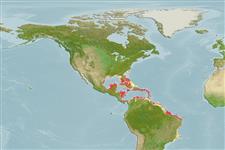Common names from other countries
Environment: milieu / climate zone / depth range / distribution range
Ekologi
laut berasosiasi dengan karang; kisaran kedalaman 0 - 33 m (Ref. 57883). Tropical
Western Central Atlantic: Bermuda, USA and northern Cuba. Sympatric with Ogilbia sabaji and O. suarezae along the shores of Florida,
Size / Weight / umur
Maturity: Lm ? range ? - ? cm
Max length : 6.0 cm SL jantan/; (Ref. 57883)
deskripsi pendek
Kunci identifiaksi (pengenalan) | Morfologi | Morfometrik
duri punggung lunak (Keseluruhan (total)) : 66 - 76; Sirip dubur lunak: 50 - 57; vertebrata, bertulang belakang: 39 - 41. Diagnosis: The species is characterized by the following: Vertebrae 11-13 + 27-29 = 39-41, dorsal fin rays 66-76, anal fin rays 50-57; outer and inner pseudoclaspers simple, triangular flaps, outer about 2 times size of inner pseudoclasper; penis tapering; opercular spine
with single, sharp tip; scale patch on cheeks with 4-6 vertical scale rows; otolith length: height ratio 2.1-2.3, sulcus not inclined; ventral fin reaching about 2/3 from ventral fin base to anal fin base (15.3-23.9, x = 20.3 % SL); body slender (13.2-17.4, x = 15.4 % SL) (Ref. 57883).
The species prefers shallow algae habitats at depths from 0 to 8 m, except for a single record off North Carolina (USNM 223537) caught at a depth of 31-33 m. A 44 mm SL female specimen (ANSP 148378) contained 2 embryos (12 mm TL) and 15 eggs (diameter 0.3 mm). A 37 mm SL female (ANSP 148378) contains 3 embryos of 8 mm TL, 1 embryo of 4 mm SL, and 10 eggs, 0.5 mm in diameter. The embryos have black eyes, but no pigmentation on head and body,
probably due to bleaching (Ref. 57883). A cryptic species, locally abundant (Ref. 34024).
Life cycle and mating behavior
Maturities | Reproduksi, perkembang biakan | Spawnings | Egg(s) | Fecundities | Larva
Møller, P.R., W. Schwarzhans and J.G. Nielsen, 2005. Review of the American Dinematichthyini (Teleostei: Bythitidae). Part II. Ogilbia. aqua, J. Ichthyol. Aquat. Biol. 10(4):133-207. (Ref. 57883)
Status IUCN Red List (Ref. 130435)
CITES (Ref. 128078)
Not Evaluated
ancaman kepada manusia
Harmless
penggunaan manusia
Perikanan: tidak ada kepentingan
Alat, peralatan
laporan khas
muat turun XML
Sumber internet
Estimates based on models
Preferred temperature (Ref.
115969): 24.9 - 28.2, mean 27.3 (based on 582 cells).
Phylogenetic diversity index (Ref.
82804): PD
50 = 0.5000 [Uniqueness, from 0.5 = low to 2.0 = high].
Bayesian length-weight: a=0.01000 (0.00244 - 0.04107), b=3.04 (2.81 - 3.27), in cm Total Length, based on all LWR estimates for this body shape (Ref.
93245).
Trophic level (Ref.
69278): 3.3 ±0.5 se; based on size and trophs of closest relatives
Daya lenting (Ref.
120179): Rendah, Waktu penggandaan populasi minimum 4.5 - 14 tahun (Assuming Fec < 100).
Fishing Vulnerability (Ref.
59153): Low vulnerability (10 of 100).
